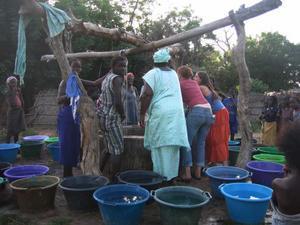Advertisement
Published: December 9th 2005

 The well
The well
This is the well at the center of the village. Each family sends several women off to the well with a pile of buckets. Girls start carrying water around age 7.In the morning, Miriama (our host) and Absa took us to the well to see the women draw water. Women surround the well from dawn till noon then again after lunch until dark. The work is shared by women of all ages. Two or three women pull on one rope at the same time with impressive coordination. They are so fast! We got to take a turn, but we had to have help—the wet rope and jug of water were really heavy. When I tried to draw water, I nearly went into the well. I was looking down into it when they dropped the bucket. I was also standing on the rope, which jerked me off balance when it came out from under me. It was probably the most frightening moment of my Senegal experience. I won’t forget the looks of oh-my-god-you-almost-died that the women next to me gave me.
When we got back to Miriama’s compound, I asked if anyone had ever fallen into the well. She said that in a nearby village, a woman was drawing water at one in the morning. She was all alone and must have lost her balance. Even though the

 Me with a bucket
Me with a bucket
I'm laughing cause I just about dropped the bucket.well was sanitized, the village wouldn’t use it for months after her death. They said in another nearby village a crazy man fell in.
There are two wells in Mbamb. The women told us that the water from the one outside the village tastes better, but it’s a tradeoff because they have to carry the water farther. They treat the each bucket of water from the nearby well with a few drops of bleach.
The fountain There is another option for the wealthier families. Several villages away there’s a water tower that supplies a fountain in Mbamb. It costs 10 cfa (about 2 cents) per bucket to get water from the fountain. A woman stands at the fountain all day to collect money. The money pays for repairs, gas for the pump, and the people who own the tower.
Whether the water comes from the well or the pump, the women have to carry it to their homes on their heads. Elizabeth, Libby, and I tried to put buckets on our heads. It was heavy, but the hardest part is that when you step, all the water sloshes and throws you off balance. The buckets hold

 The health room
The health room
This is the multipurpose health room in Mbamb. The midwife is holding up a sign for a nutritional improvement program. The bowls next to her are used for cooking demonstrations. She holds training sessions here for new moms. This is also where most Mbamb women have their babies.10 liters each (2.6 gallons). That weighs 22 pounds, in case you’re curious.
The midwife There isn’t a health post in the village. Instead, people bring their health problems to Aisatou. She’s been to some training sessions and is the local expert on everything from midwifery to nutrition. She delivers most of the babies who are born in the village. If a woman has problems during the delivery, they put her into a horse-drawn buggy and take her along a rutted dirt road to the health center 10 miles away. Aisatou holds classes to teach mothers how to better feed their children. She is also the one to give out vaccines. One day I saw her explaining the directions on a pill bottle to a woman. Apparently the woman had gotten the medicine for her daughter from the pharmacy, but didn’t understand how to use it. Aisatou really impressed me; she does a little of everything and doesn’t really get paid for it. Her husband is her main support, but the women she helps sometimes bring her gifts.
The chameleon I scared the crap out of a big group of Senegalese women one day after lunch. We were
all sitting around under a shade tree, and one of them pointed to a chameleon on the fence. It looked neat, and I wanted to see what would happen if I put it on another surface. When I reached out to grab it, all the women yelled at once. They scared me so I dropped it. I tried to explain that it was ok, that my friend has two of them as pets. But they didn’t really understand the concept of pets; I think they just thought I had a weird friend…
Advertisement
Tot: 0.133s; Tpl: 0.012s; cc: 9; qc: 73; dbt: 0.0745s; 1; m:domysql w:travelblog (10.17.0.13); sld: 1;
; mem: 1.2mb

 The well
The well
 Me with a bucket
Me with a bucket
 The health room
The health room









Mommy
non-member comment
Holly with a bucket on her head! Priceless! What an experience. This page is a bit more upbeat than the bathroom on the last page....YUCK!!! I can see why you would have mixed feelings about leaving. love you, mommy